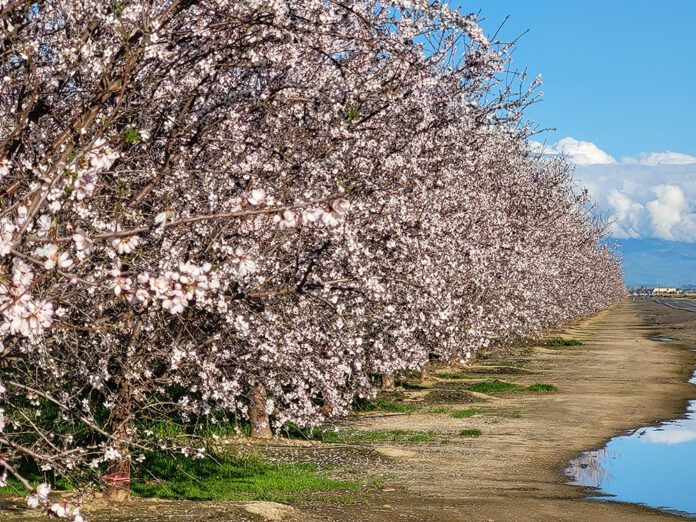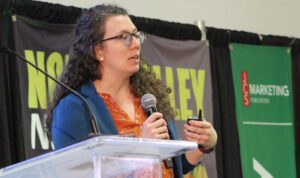
Recent UC Davis cost and return studies on almond and walnut in the Sacramento Valley showed low prices and high input costs have been significant in lowering profitability for growers. Results from the studies, which are enterprise budgets for various California crops, were discussed at the North Valley Nut Conference on January 31 in Chico, Calif.
While the results were notably not positive, presenter Brittney Goodrich, an assistant professor of cooperative extension at UC Davis, hoped to provide strategies that growers can use to try to come out ahead in these trying times by evaluating profitability in their operations.
Almond Study Estimates
Goodrich presented 2023 preliminary estimates for the Sacramento Valley almond production cost and returns study and compared preliminary estimates with the same study completed in 2019. It presumed 100 acres with 124 trees per acre at a 16’ x 22’ spacing and assumed traditional varieties planted. Microsprinkler irrigation with a 25-year life span and production year yield was also assumed at 2,200 lbs/acre. Labor costs included taxes and workers compensation, with equipment labor at $28.60/hour and non-equipment labor at $25.74/hour.
“Overwhelmingly, you see everything is increasing in price; unfortunately, all of our inputs are increasing, but then our almond prices are not increasing, so it’s not looking super promising,” Goodrich said, but noted the numbers were preliminary and may be subject to change before publishing.
The estimates showed prices increased across the board, with costs like insecticides growing with the addition of mating disruption considerations as well as increased water costs.
Goodrich said while it looks like labor costs are decreasing on paper, that’s just because they added a custom pesticide application that’s not done by the farmworkers on the farm.
“So, then they’ve taken that out of the labor costs, but overall labor costs are increasing since 2019,” she said.
Interest rates have also increased significantly to 8.5%, compared to 5.25% in 2019.
“In order to break even on operating costs, we’d need about $1.74/pound on almonds,” she said. “We’re not quite there, so we’re losing a little bit of money this year.”
Cash overhead, which includes various expenses assigned to a whole farm and not a particular operation, such as office expenses, have increased by about 38%, Goodrich explained. These included environmental and regulatory fees, which increased across this study as well as other studies, she said. This category also showed crop insurance numbers at a 70% coverage level at about $42/acre.
“For those of you thinking about crop insurance options, there are cheaper options available, especially in times when prices are relatively low like they are now,” she said.
The study looked at non-cash overhead costs like capital recovery costs for equipment and other farm investments where you need to pay on a loan each year.
“Orchard establishment costs have more than doubled,” she said, which is due to the high interest rates. “So, that’s part of the reason why that orchard establishment cost is increasing quite substantially.”
Net returns also didn’t look good in the study, which showed them in the negative.
“We’re not covering our operating costs in this orchard, and that’s just not a sustainable way to move forward in farming,” Goodrich said.
Walnut Study Estimates
Goodrich presented results from the Sacramento Valley cost and return study on walnuts, which was published in 2022, and she compared costs with the same study completed in 2018. It looked at 100 acres with 64 trees/acre at a 26’ x 26’ spacing on Chandler or clonal Paradox rootstocks. Like the almond study, it considered microsprinkler irrigation. The life production assumed was 30 years, and labor costs included an additional 45% for taxes and worker compensation and put equipment operator costs at $26.10/hour and non-equipment costs at $22.48/hour with production at 6,000 lbs/acre.
The study showed a similar story to the almond study, showing that everything increased, Goodrich said.
“Everything from labor, machinery, water, again, has increased substantially; we’re using $16/acre-inch, and then fairly low walnut prices in 2022,” she said.
The breakeven operating cost per pound was 57 cents, and the study used 50 cents per pound.
“Again, we’re not recouping our operating costs,” Goodrich said.
Similar in terms of cash overhead costs, she said they didn’t change a lot of aspects between 2018 and 2022, so the main increases were on property tax and insurance. Also, non-cash overhead costs increased by about 41% due to orchard investment costs increasing substantially due to much higher interest rates.
“We’re not making money, it’s not sustainable, but hopefully we can get to a point where we have slightly higher prices and we can at least be covering our operating costs each year,” Goodrich said.
She said it’s really important for growers to consider break-even prices to reflect what the minimum price needed would be in order to cover costs of production. For walnuts, she said that number would need to be about $1.24/lb in order to cover all costs, which takes into account the high interest rates.

“If you established your walnut orchard 15 years ago, you’re not going to have to cover $1.24 because you had a much cheaper loan that you’ve taken out,” she said.
For almonds, she said the break-even rate to cover total costs was much higher at $3.29.
“When I saw that, I was pretty surprised. It seems not sustainable and not realistic,” Goodrich said, adding there may be changes that happen, but again, part of that is interest rates.
Goodrich examined changes in the gross domestic product implicit price deflator as a measure of inflation and showed that the break-even price for walnuts increased from 35% to 39% and almonds increased from 43% to 45%, while regular inflation is increasing at 15% to 17%.
“What that means is our input costs are increasing way more rapidly than the overall inflation of the economy as a whole, which is unfortunate,” she said.
Tools and Tips for Survival
Growers interested in examining how costs have fluctuated over the years can use UC Davis’s cost study website to see the costs and returns on a number of crops along with archive studies dating all the way back to the 1930s.
The site recently started providing Excel spreadsheets, in addition to the PDF formats, to help growers update their own costs. The spreadsheets are currently available for walnuts and prunes and will be available soon for almonds.
“As walnut or almond prices change, you can use that to kind of look at the dynamic nature of farming,” Goodrich said.
UC Davis also has a navel orangeworm (NOW) IPM economic calculator available for almond and will expand to walnuts and pistachios in the future. The calculator, available on the cost and return study page, will allow growers to plug in expected price and yield in their orchard and then plug in any costs associated with your NOW IPM, such as winter sanitation, mating disruption and pesticides per acre.
Goodrich, who grew up in Iowa, likes to think about the economics of farming like a corn or soybean grower would.
“We need to think about profit maximization, we don’t want to think about cost minimization; you can’t just spend the least amount because that may have repercussions like what we saw with NOW this past year,” she said. “And we’re not necessarily trying to maximize yield because you can spend a ton of money to try and maximize yield, but does that actually make sense?”
Goodrich said it’s important to think about all the possible repercussions of the production practices as you make them. For example, decreasing your target walnut yield from 6,000 lbs/acre to 5,000 lbs/acre while reducing revenue a bit would also reduce costs elsewhere, she explained, such as with irrigation, fertilizer and pest control.
“It’s really about trying to get folks to think about things in a creative way, because that’s what we have to be doing right now,” she said.
Adjusting crop insurance policies can also be a way to save on costs, but Goodrich warns against making any changes without consulting your crop insurance agent first. With crop insurance costs in the almond study showing about $42/acre, she said there are ways to balance the cost a bit. Growers may want to consider catastrophic protection, since it’s highly subsidized and only costs $655 per crop, per county, regardless of the number of acres.
“If you’re thinking about cutting your crop insurance, maybe don’t cut it all the way; enroll in that catastrophic protection instead,” she said.
Both the almond and walnut cost studies and Excel spreadsheet tools are available at https://coststudies.ucdavis.edu/.

Kristin Platts | Digital Content Editor and Social Correspondence
Kristin Platts is a multimedia journalist and digital content writer with a B.A. in Creative Media from California State University, Stanislaus. She produces stories on California agriculture through video, podcasts, and digital articles, and provides in-depth reporting on tree nuts, pest management, and crop production for West Coast Nut magazine. Based in Modesto, California, Kristin is passionate about sharing field-driven insights and connecting growers with trusted information.















